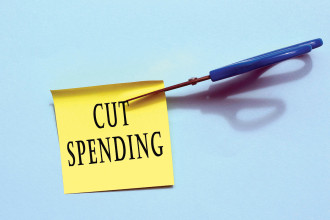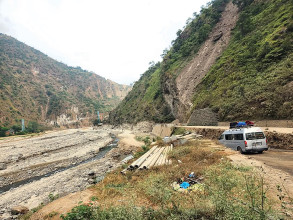
Commercial banks (Class ‘A’ banks) have booked relatively sound profit with a surge of 13.4% in fiscal 2023/24 as compared to the previous fiscal 2022/23. Twenty commercial banks in operation have secured Rs 64.15 billion profit in FY 2023/24 compared to Rs 56.57 billion of the previous fiscal, according to the financial statements disclosed by the commercial banks.
Credit growth in FY 2023/24 almost doubled to 5.6% against a meagre 3% credit growth in FY 2022/23. Interest income from credit is the main source of earnings for banks and financial institutions (BFIs), and retarded credit growth hits the banks hard. Nepal Rastra Bank – central regulatory and monetary authority – had projected private sector credit growth of 11.5%, however, credit growth remained far below the projection due to a slump in credit demand due to the slowdown in economic activities, according to Sunil KC, President of Nepal Bankers’ Association (NBA) and CEO of NMB Bank.
“Bank’s profits declined as they’ve to set aside more funds as loan loss provisioning as the amount of loss loan (NPL) has increased by 0.53 percentage points in the last one year,” he added.
Further, credit did not increase as anticipated as big borrowers are already overburdened with debt and have no appetite for taking more credit from BFIs.
Banks were focused more on recovery rather than credit expansion in FY 2023/24. The economic downturn adversely affected the recovery of banks. Non-performing loans shot up to 3.54% from 3% of the previous fiscal year. Credit expansion capacity of banks and financial institutions (BFIs) declines when the NPL goes up.
Despite the challenging situation, three commercial banks have generated profit of above Rs 5 billion, namely, Nabil Bank (Rs 7.06 billion), Global IME Bank (Rs 6.01 billion) and Nepal Investment Mega Bank (Rs 5.19 billion). Other two banks in the top five are Prabhu Bank (Rs 4.48 billion) and Prime Commercial Bank (Rs 3.77 billion).
Nepal Investment Mega Bank, Prabhu Bank and Prime Commercial Bank have generated sound profit despite their high NPL of 4.95%, 4.78% and 4.67%, respectively.
The bottom five banks in terms of profit of FY 2023/24 are Machhapuchchhre Bank (Rs 1.25 billion), Citizens Bank (Rs 1.34 billion), NIC Asia Bank (Rs 1.38 billion), Nepal Bank (Rs 1.65 billion) and Nepal SBI Bank (Rs 2.01 billion).
Total credit mobilisation of commercial banks till end of fiscal 2023/24 hovers at Rs 4,515.45 billion, which is almost near to the country’s Gross Domestic Product (GDP) of Rs 5,704.84 billion.
Rising NPL and its adverse impact on the economy
Rising NPL has exposed the recovery challenges for banks and financial institutions. NPL increased exponentially from merely 1.33% in mid-July 2022 to 3.4% in mid-July 2023 and it further expanded to 3.54% as of mid-July 2024. The consistent rise in NPL has vindicated concerns of the International Monetary Fund (IMF) regarding the asset quality of BFIs. IMF has been urging the central bank for loan reclassification.
Many believe that the reported figure significantly understates the actual NPL situation. One key criterion for determining NPL is loan ageing. A loan downgraded from the ‘pass’ category to ‘watchlist’ requires a 5% loan loss provision if repayment is delayed for one to three months. If overdue for three to six months, it becomes ‘substandard’ with a 25% provision. Further delay of six to 12 months classifies the loan as ‘doubtful’, necessitating a 50% provision. Loans overdue for more than a year are categorised as ‘loss’ with a 100% provision.
Loans are currently classified by computers based on repayment status, which is believed to underestimate non-performing loans (NPLs). BFIs have not traditionally classified loans as ‘doubtful’ or ‘loss’ based on improper usage. Accurate NPL calculation requires on-site inspections by both BFIs and Nepal Rastra Bank to verify loan utilisation. NRB officials acknowledge that relying solely on regular debt servicing without verification can lead to misleading information and harm both lenders and borrowers.
Considering the imprudent practices of NPL monitoring, IMF, through its Extended Credit Facility (ECF) programme, has asked Nepal Rastra Bank to audit the asset quality portfolios of the top 10 banks through internationally renowned audit firms. If the audit report paints a bleak picture of asset quality, then a substantial recapitalisation might be required.
However, bankers have said that the rise in NPL is due to consistently high interest rate of BFIs and downturn in economic activities. Once the economy rebounds, recovery is expected to improve. NBA President KC remarked that the accommodative Monetary Policy for FY 2024/25 could help the economy bounce back in the near-term and subsequently recovery of loans will also improve. However, he admitted to the fact that over indebtedness of borrowers should be cautiously taken care of.
Against this backdrop, while coming to the end of FY 2023/24, commercial banks have not been able to recover Rs 159.84 billion, which is a substantial amount. Constraints in credit recovery adversely affect the health of BFIs. Not only the operating efficiency but the lending capacity will also deteriorate.
In consideration of this outlook, Nepal Rastra Bank should take immediate actions to lower the NPL. NRB, however, has announced to formulate the draft Bill for establishing Asset Management Company (AMC) to manage and enhance recoveries of distressed assets which have been removed from the banking system.
The loans mobilised by banks is the money of the depositors, which banks will have to ultimately return. Rising NPL could create distrust among the people regarding banks and the financial system of the country as a whole. On the other hand, the government might have to use scarce resources for recapitalisation in banks. “Banks contribute to attaining economic growth by mobilising credit to the private sector and rising NPL deteriorates the lending capacity of banks,” according to Dr Chiranjibi Nepal, former Governor of Nepal Rastra Bank. “The central bank has to quash the imprudent lending practices of the banks and penalise those who avail credit with ill intention and use it improperly,” he stated.
Otherwise, genuine borrowers, mainly entrepreneurs could be deprived of credit and ultimately the country has to suffer as production and jobs will decline, according to Nepal.
Commercial banks earned a combined net profit of Rs 64.15 billion in the Fiscal Year 2023/24, a 13.4% increase from the net profit of Rs 56.57 billion reported by 20 commercial banks in the Fiscal Year 2022/23. Ten commercial banks saw their net profits rise while the remaining ten have reported a decline.
Rising NPL hits profit of banks
Rising NPLs not only erode bank profits but also pose significant risks to financial sector stability if left unchecked. Banks with substantial loan portfolios are grappling with high NPL rates. NRB officials have urged these banks to adopt prudent lending practices, highlighting risky sectors and instances of imprudent lending. Bankers have been summoned for discussions to address these concerns.
Among 20 commercial banks in operation, Everest (0.71%), Sanima Bank (1.73%), Nepal SBI Bank (2%), Standard Chartered Bank (2.14%) and Siddhartha Bank (2.22%) have the lowest NPL. However, Laxmi Sunrise Bank (4.72%), Prabhu Bank (4.78%), Himalayan Bank (4.91%), Nepal Investment Mega Bank (4.95%) and Kumari Bank (4.95%) have high NPL. Considering the outstanding loan portfolio, Global IME Banks has the highest NPL of Rs 16.74 billion, followed by Nepal Investment Mega Bank with Rs 15.82 billion, Nabil Bank with Rs 14.86 billion, Kumari Bank with Rs 14.05 billion and Laxmi Sunrise Bank with Rs 12.19 billion. These five banks carry 46.08% share in total NPL of commercial banks.
In fiscal 2023/24, banks generated a profit of Rs 64.15 billion, however, the NPL of commercial banks shot up to Rs 159.84 billion. This situation is quite alarming and has raised the eyebrows of policy makers and public intellectuals.
Banks’ loan portfolio, NPL and Profit
|
Bank |
Total Loan (Rs in billion) |
NPL (Rs in billion) |
Profit (Rs in billion) |
|
Nabil Bank |
386.12 |
14.86 |
7.6 |
|
Global IME Bank |
383.22 |
16.74 |
6.01 |
|
Nepal Investment Mega Bank |
319.75 |
15.82 |
5.19 |
|
Kumari Bank |
283.94 |
14.05 |
2.3 |
|
NIC Asia Bank |
283.36 |
9.66 |
1.38 |
|
Rastriya Banijya Bank |
260.86 |
9.52 |
3.39 |
|
Laxmi Sunrise Bank |
258.35 |
12.19 |
3.03 |
|
Himalayan Bank |
242.81 |
11.92 |
2.83 |
|
Prabhu Bank |
234 |
11.18 |
4.48 |
|
Agricultural Development Bank |
205.04 |
7.05 |
3.65 |
|
Nepal Bank |
203.45 |
6.67 |
1.65 |
|
NMB Bank |
202.55 |
6.62 |
2.33 |
|
Siddhartha Bank |
201.08 |
4.46 |
3.01 |
|
Prime Bank |
190.39 |
8.89 |
3.77 |
|
Everest Bank |
187.3 |
1.33 |
3.7 |
|
Sanima Bank |
165.01 |
2.85 |
2.38 |
|
Citizens Bank |
155.15 |
6.31 |
1.34 |
|
Nepal SBI Bank |
132.25 |
2.64 |
2.01 |
|
Machhapuchchhre Bank |
132.2 |
4.79 |
1.25 |
|
Standard Chartered Bank |
88.62 |
1.89 |
3.3 |
|
Total |
4515.45 |
159.84 |
64.15 |
(Source: Financial statements of commercial banks, FY 2023/24)
Text: Pushpa Raj Acharya






